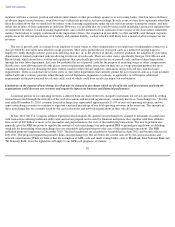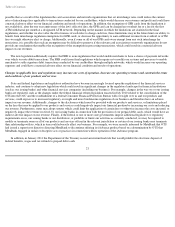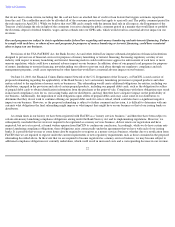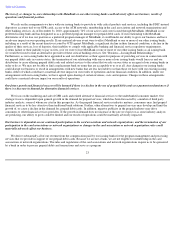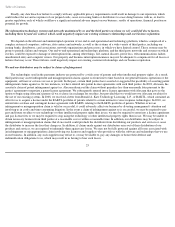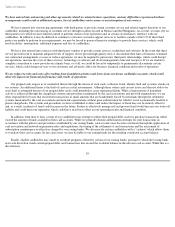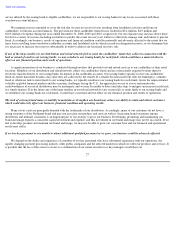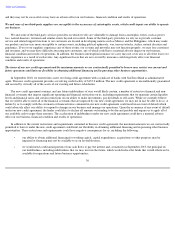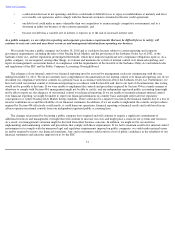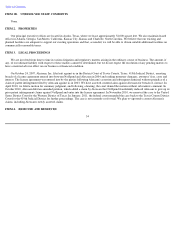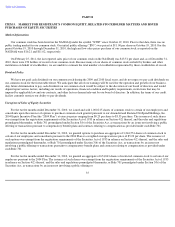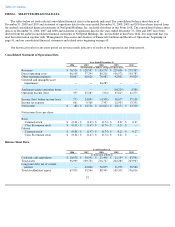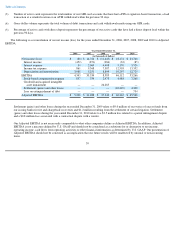NetSpend 2010 Annual Report Download - page 33
Download and view the complete annual report
Please find page 33 of the 2010 NetSpend annual report below. You can navigate through the pages in the report by either clicking on the pages listed below, or by using the keyword search tool below to find specific information within the annual report.
Table of Contents
• increasing costs and complexity associated with the maintenance of adequate internal control and disclosure controls and
procedures; and
• loss of key personnel.
The anticipated benefit to us of any strategic transactions, acquisitions or mergers may never materialize. For example, in 2008 we
recorded an impairment of goodwill and acquired intangible assets related to our acquisition of Skylight in the amount of $26.3 million. Future
investments, acquisitions or dispositions could result in dilutive issuances of our equity securities, a reduction in our cash reserves, the
incurrence of additional debt, contingent liabilities or amortization expenses, or write-offs of goodwill, any of which could have an adverse
effect on our business, financial condition and operating results.
If we are unable to adequately protect our intellectual property and other proprietary rights, we may lose a valuable competitive advantage
or be forced to incur costly litigation to protect our rights.
Our success depends in part on developing and protecting our intellectual property and other proprietary rights. We rely on a combination
of patent, trade secret, copyright and trademark laws, as well as licenses of intellectual property from third parties, to protect our intellectual
property and conduct our business in a manner that does not infringe or misappropriate the intellectual property of third parties. We also rely on
other confidentiality and contractual agreements and arrangements with our employees, affiliates, business partners and customers to establish
and protect our intellectual property and similar proprietary rights. We have one patent registered and four patent applications pending with the
United States Patent and Trademark Office, including applications related to our payment processing platform and business methods. These
patent applications may not become issued patents. If they do not become issued patents, our competitors would not be prevented from using
these inventions.
Existing laws afford only limited protection for our intellectual property rights. Intellectual property rights or registrations granted to us
may provide an inadequate competitive advantage to us or be too narrow to protect our products and services. The protections outlined above
may not be sufficient to prevent unauthorized use, misappropriation or disclosure of our intellectual property or technology and may not
prevent our competitors from copying, infringing, or misappropriating our products and services. It is possible that others will independently
develop, design around or otherwise acquire equivalent or superior technology or intellectual property rights. If we are unable to adequately
protect our intellectual property rights, our business and growth prospects could be materially and adversely affected.
Our failure to anticipate rapid changes in technology may negatively affect demand for our services in the marketplace.
The electronic payments industry is subject to rapid and significant technological changes. We expect that new services and technologies
applicable to our industry will continue to emerge, and these new services and technologies may be superior to, or render obsolete, the
technologies we currently utilize in our products and services. Additionally, we may make future investments in, or enter into strategic
alliances to develop, new technologies and services or to implement changes to our operating platform to further our growth prospects,
strengthen our existing businesses and remain competitive. However, our ability to transition to new services and technologies that we develop
may be inhibited by a lack of industry-wide standards, by resistance from our distributors, network acceptance members, third-party network
processors or consumers to these changes, or by the intellectual property rights of third parties. Our future success will depend, in part, on our
ability to develop new technologies and adapt to technological changes and evolving industry standards. These initiatives are inherently risky,
29



